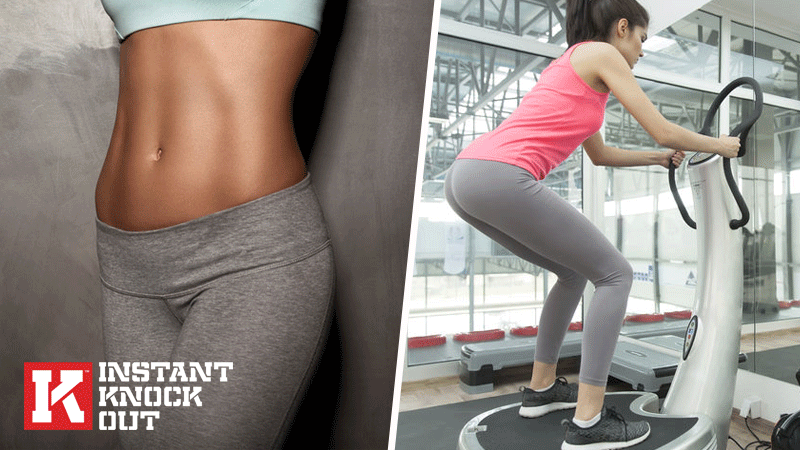Do Fat Loss Vibration Machines Work?

The journey to your ideal physique is full of challenges.
What training do you put in your program? Which diet and supplements do you take?
These are things that make the big difference.
So making sure you’ve got the right nutrients in your eating plan and nailing the right workouts are key to successful body transformation.
Could vibration training be one of the methods to help you get to that finish line?
In this article we take a look…
What is Vibration Training?
Whole body vibration training (WBVT) is a type of physical activity involving “repeated mechanical stimuli characterized by an oscillatory motion” [1].
Simply, it’s a large plate that you stand on and it vibrates quickly whilst you exercise.
Vibration plates move or ‘oscillate’ (travel up and down or side to side) at different frequencies and amplitudes – usually between 15 and 60 Hz. The depth of the oscillation can also be adapted from 1 mm to more than 10 mm dependent on the manufacturer.
These plates can be used with slow and deeper oscillations, or they can be short, sharp and fast.
Manufacturers say that you can exercise on them – squats, deadlifts, press-ups and ab curls can all be performed on the plate.
Or that you might prefer to either just sit or lie on it – maybe even incorporate stretching on it. And whilst this reduces the overall energy burned on in comparison to a full-on workout, it may still offer some unique benefits.
What Are The Benefits of Vibration Training?
Every time you move you interact with the external environment that surrounds you.
When you walk, jump, lift weights and so on you experience an applied external force. These forces induce tension, load and vibrations throughout our skeletal and muscular tissues.
It happens hundreds of times over the course of a day.
For example, every time you walk you send vibrations throughout your leg. Clapping and grabbing sends them through the hands and arms. When you drive your car you experience hundreds of oscillations just through the vibration of the vehicle driving over the road.
And it’s this mechanical effect that WBVT uses.
But why would you use it? What are the benefits?
Vibration training can improve athletic ability
A variety of studies have shown that WBVT of different intensities and volumes can increase speed, power and strength.
For example, when a group of women took part in 24-weeks of oscillation-based training, they improved quad strength and speed [2].
And another study reported that regular WBVT improved muscle mass, bone mineral content, functional strength and endurance when used for 9-minutes over a 20-week basis [3].
Finally, performing a strength session on a vibrating plate rather than in the free weights area led to improvements in balance, muscle endurance and jumping power too [4].
Not all research shows performance benefits though
The positive impact on physical athleticism doesn’t carry across to every research study.
For example, when 20 sprinters added vibration training into their existing training program 3 times per week, it had no effect on strength, acceleration or sprinting ability [5].
Vibration training can improve health
As well as athletic performance, WBVT may also help to reduce the risk of ling-term illness.
Studies have shown that regular oscillation activity can reduce the risk of stroke, diabetes, osteoporosis and chronic pulmonary disease. It can also help women manage the symptoms of menopause too [6].
And whilst the exact mechanism behind how they work is either complex or unknown, it does provide a positive rationale for their use.
But let’s be right… WBVT is usually sold on its ‘fat loss’ benefits
The biggest selling point made by manufacturers of vibration plates is that they can help you lose weight and drop fat.
You’ll find them not just in professional sports clubs and high end facilities but also in your local beauty parlor as well.
The big emphasis on vibration training is usually that they can help you cut, shred and transform your body.
But can they?
Key Point: Although the evidence isn’t conclusive, vibration training does appear to boost athleticism and health in some studies
The Science – Does Vibration Training Help With Fat Loss?
In the grand scheme of things, WBVT is a new training modality – it’s a baby compared to traditional weight training and cardio.
And that’s reflected in the fact that there hasn’t been a great deal of research completed on it to date.
But even as a ‘young’ method of training, manufacturers don’t shy from making bold claims about its fat loss benefits.
Only 1o minutes of vibration training a day is the equivalent of an hours’ cardio” are the type of things you’ll hear on a regular basis.
But does standing on an oscillating plate really lead to fat loss?
Study #1: Rubio-Arias et al [7]
One study, published at the Department of Sport Sciences and Physical Activity in Murcia, Spain, found that using WBVT over 6 weeks had no effect on body composition.
Using a vibration plate for three sessions a week and using a variety of different intensities (increasing week by week), a group of 64 healthy adults took part in 6 weeks of WBVT to improve elite performance.
The researchers took various measurements from the athletes, looking to see if it would have any effect. It didn’t.
Study #2:Roelants et al [8]
In this study, 48 untrained females were split into one of two group.
One group took part in a 24-week WBVT training program consisting of a range of both static and dynamic exercises. They did this three times per week.
The other group followed a traditional program of cardio and resistance training – again for three times per week.
Both groups had their body weight and fat taken both at the start of the program and at the end. To measure fat levels, researchers used calipers to measure skinfolds, and a technique called hydrostatic weighing – a very precise method involving underwater fat mass measurements.
Both groups increased the amount of muscle that they had, showing that both methods of training were useful in adding fat free mass. It wasn’t a massive amount, but it was an increase nonetheless.
Both groups also increased their strength as well.
But when it came to fat mass there was no difference recorded. It was the same for their weight too, which didn’t change (and in some cases went up).
Summary
Although a relatively new method of physical activity, vibration training has been found to offer a range of performance and health benefits. These aren’t seen in all studies, but do appear promising.
But when it comes to weight loss or fat mass reduction, vibration training doesn’t appear to offer any additional benefit, and traditional training seems to still be more effective when it comes to weight management.



